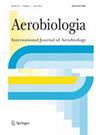Automatic detection of airborne pollen: an overview
IF 2.2
3区 环境科学与生态学
Q2 BIOLOGY
引用次数: 0
Abstract
Pollen monitoring has traditionally been carried out using manual methods first developed in the early 1950s. Although this technique has been recently standardised, it suffers from several drawbacks, notably data usually only being available with a delay of 3–9 days and usually delivered at a daily resolution. Several automatic instruments have come on to the market over the past few years, with more new devices also under development. This paper provides a comprehensive overview of all available and developing automatic instruments, how they measure, how they identify airborne pollen, what impacts measurement quality, as well as what potential there is for further advancement in the field of bioaerosol monitoring.
空气中花粉的自动检测综述
传统上,花粉监测都是采用人工方法进行的,这种方法最早开发于 20 世纪 50 年代初。虽然这种技术最近已实现标准化,但仍存在一些缺陷,特别是数据通常只能延迟 3-9 天提供,而且通常以日分辨率提供。过去几年,市场上出现了几种自动仪器,还有更多新设备正在开发中。本文全面概述了所有现有的和正在开发的自动仪器,它们是如何测量的,如何识别空气中的花粉,哪些因素会影响测量质量,以及在生物气溶胶监测领域有哪些进一步发展的潜力。
本文章由计算机程序翻译,如有差异,请以英文原文为准。
求助全文
约1分钟内获得全文
求助全文
来源期刊

Aerobiologia
环境科学-环境科学
CiteScore
4.50
自引率
15.00%
发文量
37
审稿时长
18-36 weeks
期刊介绍:
Associated with the International Association for Aerobiology, Aerobiologia is an international medium for original research and review articles in the interdisciplinary fields of aerobiology and interaction of human, plant and animal systems on the biosphere. Coverage includes bioaerosols, transport mechanisms, biometeorology, climatology, air-sea interaction, land-surface/atmosphere interaction, biological pollution, biological input to global change, microbiology, aeromycology, aeropalynology, arthropod dispersal and environmental policy. Emphasis is placed on respiratory allergology, plant pathology, pest management, biological weathering and biodeterioration, indoor air quality, air-conditioning technology, industrial aerobiology and more.
Aerobiologia serves aerobiologists, and other professionals in medicine, public health, industrial and environmental hygiene, biological sciences, agriculture, atmospheric physics, botany, environmental science and cultural heritage.
 求助内容:
求助内容: 应助结果提醒方式:
应助结果提醒方式:


